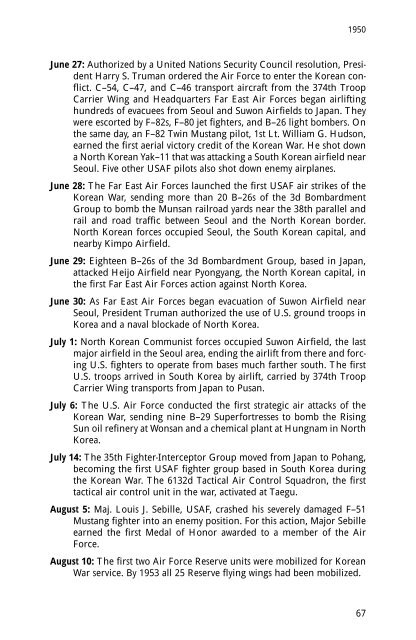One Hundred Years of Flight USAF Chronology ... - The Air University
One Hundred Years of Flight USAF Chronology ... - The Air University
One Hundred Years of Flight USAF Chronology ... - The Air University
Create successful ePaper yourself
Turn your PDF publications into a flip-book with our unique Google optimized e-Paper software.
1950<br />
June 27: Authorized by a United Nations Security Council resolution, President<br />
Harry S. Truman ordered the <strong>Air</strong> Force to enter the Korean conflict.<br />
C–54, C–47, and C–46 transport aircraft from the 374th Troop<br />
Carrier Wing and Headquarters Far East <strong>Air</strong> Forces began airlifting<br />
hundreds <strong>of</strong> evacuees from Seoul and Suwon <strong>Air</strong>fields to Japan. <strong>The</strong>y<br />
were escorted by F–82s, F–80 jet fighters, and B–26 light bombers. On<br />
the same day, an F–82 Twin Mustang pilot, 1st Lt. William G. Hudson,<br />
earned the first aerial victory credit <strong>of</strong> the Korean War. He shot down<br />
a North Korean Yak–11 that was attacking a South Korean airfield near<br />
Seoul. Five other <strong>USAF</strong> pilots also shot down enemy airplanes.<br />
June 28: <strong>The</strong> Far East <strong>Air</strong> Forces launched the first <strong>USAF</strong> air strikes <strong>of</strong> the<br />
Korean War, sending more than 20 B–26s <strong>of</strong> the 3d Bombardment<br />
Group to bomb the Munsan railroad yards near the 38th parallel and<br />
rail and road traffic between Seoul and the North Korean border.<br />
North Korean forces occupied Seoul, the South Korean capital, and<br />
nearby Kimpo <strong>Air</strong>field.<br />
June 29: Eighteen B–26s <strong>of</strong> the 3d Bombardment Group, based in Japan,<br />
attacked Heijo <strong>Air</strong>field near Pyongyang, the North Korean capital, in<br />
the first Far East <strong>Air</strong> Forces action against North Korea.<br />
June 30: As Far East <strong>Air</strong> Forces began evacuation <strong>of</strong> Suwon <strong>Air</strong>field near<br />
Seoul, President Truman authorized the use <strong>of</strong> U.S. ground troops in<br />
Korea and a naval blockade <strong>of</strong> North Korea.<br />
July 1: North Korean Communist forces occupied Suwon <strong>Air</strong>field, the last<br />
major airfield in the Seoul area, ending the airlift from there and forcing<br />
U.S. fighters to operate from bases much farther south. <strong>The</strong> first<br />
U.S. troops arrived in South Korea by airlift, carried by 374th Troop<br />
Carrier Wing transports from Japan to Pusan.<br />
July 6: <strong>The</strong> U.S. <strong>Air</strong> Force conducted the first strategic air attacks <strong>of</strong> the<br />
Korean War, sending nine B–29 Superfortresses to bomb the Rising<br />
Sun oil refinery at Wonsan and a chemical plant at Hungnam in North<br />
Korea.<br />
July 14: <strong>The</strong> 35th Fighter-Interceptor Group moved from Japan to Pohang,<br />
becoming the first <strong>USAF</strong> fighter group based in South Korea during<br />
the Korean War. <strong>The</strong> 6132d Tactical <strong>Air</strong> Control Squadron, the first<br />
tactical air control unit in the war, activated at Taegu.<br />
August 5: Maj. Louis J. Sebille, <strong>USAF</strong>, crashed his severely damaged F–51<br />
Mustang fighter into an enemy position. For this action, Major Sebille<br />
earned the first Medal <strong>of</strong> Honor awarded to a member <strong>of</strong> the <strong>Air</strong><br />
Force.<br />
August 10: <strong>The</strong> first two <strong>Air</strong> Force Reserve units were mobilized for Korean<br />
War service. By 1953 all 25 Reserve flying wings had been mobilized.<br />
67

















